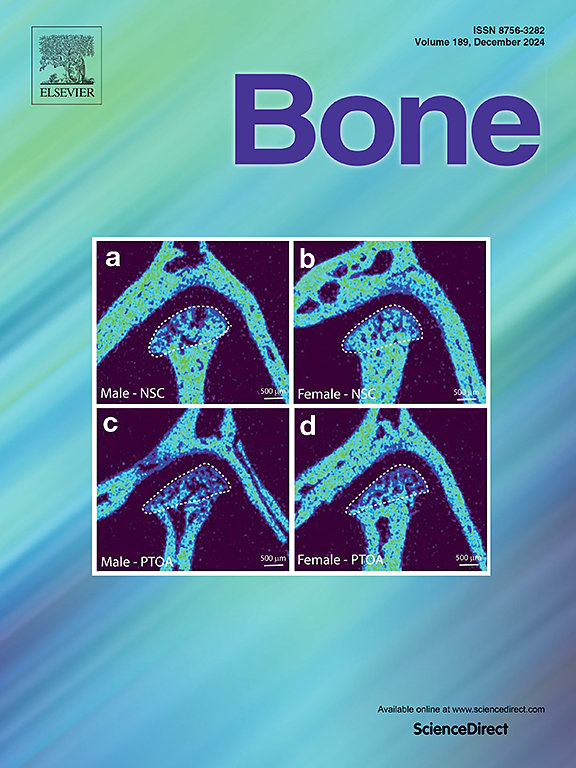Acute pain trajectories in elderly patients with fragility hip fractures
IF 3.5
2区 医学
Q2 ENDOCRINOLOGY & METABOLISM
引用次数: 0
Abstract
Background
Pain management for hospitalized elderly patients with fragility hip fractures (FHF) remains challenging. This study aims to distinguish acute pain trajectories in FHF patients that can inform personalized analgesia management.
Methods
We conducted a prospective observational study of patients aged 65 and older with FHF at a Level I trauma center. The primary outcome was daily average pain assessed for five days post-injury using the Brief Pain Inventory (BPI). We used group-based trajectory modeling (GBTM) to distinguish acute pain trajectories. Then, factors and secondary outcomes (opioid use and hospital length of stay [LOS]) associated with more severe pain trajectories were identified.
Results
We enrolled 100 consecutive patients with FHF between June 2022 and June 2023. We identified three distinct acute pain trajectories: minimal pain, subsiding pain, and persistent pain. Factors associated with more severe pain trajectories included higher initial pain on admission (OR 1.17, 95 % CI 1.02–1.36, P = 0.047), higher BMI (OR 1.15, 95 % CI 1.02–1.29, P = 0.021), and intertrochanteric fracture type (OR = 6.46, 95 % CI 1.49–27.98, P = 0.013). The persistent pain trajectory was significantly associated with 40 % more opioid use (P = 0.01) and a longer LOS (LOS ratio = 1.45, 95 % CI 1.21–1.74, P < 0.001).
Conclusion
Acute pain in FHF patients can be classified into distinct trajectories, providing a basis for personalized pain management. More severe pain trajectories are associated with higher opioid use and longer length of hospital stay.
老年脆性髋部骨折患者的急性疼痛轨迹
背景:老年脆性髋部骨折(FHF)住院患者的疼痛管理仍然具有挑战性。本研究旨在区分FHF患者的急性疼痛轨迹,为个性化镇痛管理提供信息。方法我们在一家一级创伤中心对65岁及以上的FHF患者进行了前瞻性观察研究。主要结果是使用简短疼痛量表(BPI)评估损伤后5天的每日平均疼痛。我们使用基于组的轨迹模型(GBTM)来区分急性疼痛轨迹。然后,确定了与更严重疼痛轨迹相关的因素和次要结局(阿片类药物使用和住院时间[LOS])。我们在2022年6月至2023年6月期间连续入组了100例FHF患者。我们确定了三种不同的急性疼痛轨迹:轻微疼痛、消退疼痛和持续疼痛。与更严重疼痛轨迹相关的因素包括入院时更严重的初始疼痛(OR 1.17, 95% CI 1.02-1.36, P = 0.047)、更高的BMI (OR 1.15, 95% CI 1.02-1.29, P = 0.021)和转子间骨折类型(OR = 6.46, 95% CI 1.49-27.98, P = 0.013)。持续疼痛轨迹与阿片类药物使用增加40% (P = 0.01)和更长的LOS (LOS比= 1.45,95% CI 1.21-1.74, P <;0.001)。结论FHF患者急性疼痛可分为不同的疼痛轨迹,为个性化疼痛管理提供依据。更严重的疼痛轨迹与更高的阿片类药物使用和更长的住院时间有关。
本文章由计算机程序翻译,如有差异,请以英文原文为准。
求助全文
约1分钟内获得全文
求助全文
来源期刊

Bone
医学-内分泌学与代谢
CiteScore
8.90
自引率
4.90%
发文量
264
审稿时长
30 days
期刊介绍:
BONE is an interdisciplinary forum for the rapid publication of original articles and reviews on basic, translational, and clinical aspects of bone and mineral metabolism. The Journal also encourages submissions related to interactions of bone with other organ systems, including cartilage, endocrine, muscle, fat, neural, vascular, gastrointestinal, hematopoietic, and immune systems. Particular attention is placed on the application of experimental studies to clinical practice.
 求助内容:
求助内容: 应助结果提醒方式:
应助结果提醒方式:


